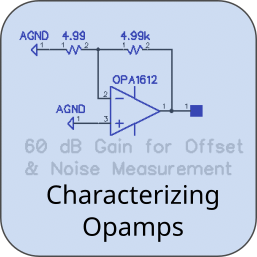
Characterizing Opamps
Share
Modern opamp specs are amazing. They come to us in a compact PDF form with outstanding vector color graphics, making it easy to know an enormous amount about the part under consideration. This is in sharp contrast to specs from decades ago, where information was limited and graphs were blurry black and white blobs in a newsprint book
But there are still times when you need to know more about an opamp you are considering.
The picture below shows an early opamp tester used to flesh out some concepts. It's not clear if it will become a product or not as it is rather specialized. The tester is USB powered and allows you to learn a lot about an opamp under conditions that might be important to you but might not be present on the data sheet.

There are a lot of relays on the board, and the generalized schematic appears as below:

The various connections options above might not make sense, but depending on the switch configuration, you can get the following configurations:

Some of these configurations will make perfect sense. But others might not. The thread HERE on the forum surfaces two interesting papers that will explain much of the above.
The first is Samuel Groner's extensive work (HERE) on characterizing opamps. Groner looks at distortion contributions based on input, output and loading.
The second paper (HERE) is by former Burr Brown engineer Jerald G Graeme. In that paper Graeme explains way to modify the signal gain and distortion/noise gain of the opamp separately. For example, you can see in Configuration 5A in the plot above a circuit with signal gain of -10 and a distortion/noise gain of 10. This corresponds to Figure 3 on page 6 of the Graeme PDF. Note in Graeme's circuit the addition of a resistor between the - and + terminals of the opamp (R3). This resistor allows you set a different gain for the error term of the opamp. Referring back to the Configuration of 5B above, the error term gain is 4.99K/(499||49.9) = 110.
It's a similar exercise for the the non-inverting case (configurations 6A and 6B). Those are shown here:

The DUT opamp used in this case is an LM358 (even though the plots say LM386--that is incorrect).
Here we can see configuration 6A (no distortion multiplier). Note the signal gain is 0 dB as expected. And we can see the THD is about -107.

Next, we switch to Configuration 6B and run the test again:

Other Tests
Currently there are 13 configurations shown above. These include configurations for measuring noise and CMRR as well as distortion for other gains (inverting and non-inverting). There is also the ability to apply 4 different loads to the opamp (infinity,2K, 600, 470 ohms). For example, below is the LM358 with no load (left) and 470 ohm load (right):

In the above plots, we can see a change in amplitude based on the load, which means we can calculate the output impedance of the opamp in closed loop configurations.
We can also look at the gain-bandwidth product of an opamp using something like the QA403 with 100 kHz of bandwidth. A really fast opamp that has a GWB of 30 MHz will have its bandwidth reduced as gain is increased. So, a 30 MHz opamp operating with a gain of 1000X will have 30 kHz of bandwidth. The 1000X gain corresponds to Configuration 1.
On the LM358, that plot appears below. Here we can see a frequency response sweep shows the 3dB rolloff occurs at 1003 Hz at 60 dB of gain. Backing out the gain, this means the GBW would 1.003 MHz. The spec sheet says the GBP of this LM358 variant is 700 kHz.

The hardware can also test PSRR of the positive and negative rails separately, and can measure input offsets. The hardware also has adjustable rails ranging from +/- 0.1V up to the full +/- 15V. And the rails can sense current, allowing Iq to be measured as well as opamp efficiency.
Summary
Over the coming months, work will be done to automate more of the tests. It should be a fun side project.
Feel free to discuss this post HERE.
If you liked the post you just read, please consider signing up for our mailing list at the bottom of the page.
